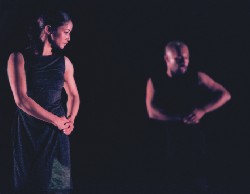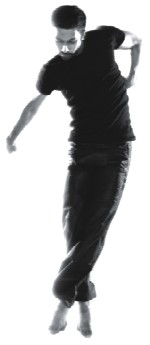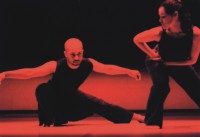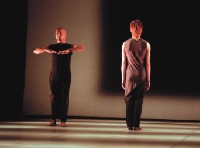| Akram
Khan
Explosion
in Contemporary Dance
Naeem
Mohaiemen
As
I walked into the Joyce Theater, I felt the thrill of
affinity. Modern dance is dominated by white performers,
and the audience tends to correspond to this. But on
this New York night, there were Asian faces scattered
throughout the sold-out show-- waiting to see the dance
world's new sensation, British-Bangladeshi virtuoso
Akram Khan.
 As
the lights dimmed, the vocabulary of Khan's muscular
and kinetic performance enveloped the auditorium. Moving
with lightning speed and gorgeous coordination, the
five-member dance troupe weaved an intricate story of
destruction, rebirth and the contemplative in-between
moments. As
the lights dimmed, the vocabulary of Khan's muscular
and kinetic performance enveloped the auditorium. Moving
with lightning speed and gorgeous coordination, the
five-member dance troupe weaved an intricate story of
destruction, rebirth and the contemplative in-between
moments.
In
one of those quieter moments, as Khan repeated "Ek,
Dui, Thin, Char, Paach" in metronomic beats, I
had a moment to savour the stillness and appreciate
what we were witnessing-- a new, global approach to
modern dance.
Akram
Khan is a red-hot "sensation." In 2001, he
was voted "Best British Dancer" for an earlier
production I saw at The Kitchen. Back then, there was
already buzz about the young dancer who had created
a synthesis between Kathak and Modern. In the two years
since, Khan's star has risen to astonishing heights.
His current performance "Kaash" is on a sold-out
worldwide tour-- going from Australia to America, and
then on to Holland, France, India, and Bangladesh. His
future work, which he is still developing, has been
booked through 2006. In two years he will return to
New York, to reach another career-high by performing
at the world-famous Lincoln Center.
Audiences
and critics are smitten. The New York Times called him
the "Agile Ambassador At Large" whose performances
are "among the most talked about in the dance world."
The Times of London rhapsodised about his "exquisitely
timed expressivity" while the Daily Telegraph wrote,
"he makes you shiver with pleasure." At the
beginning of the latest tour, The Guardian predicted
that this would be "the event of the year."
When "Kaash" opened, it was earth-shattering--
a "dark star of a dance" that turned the world
on its head.
 The
29 year-old dancer's story is well known. Almost every
review contains the sentence "Akram Khan was born
in London to Bangladeshi parents". Khan started
dancing at Bangali cultural functions when he was only
three. At age seven, his mother sent him for training
under Sri Pratap Pawar in London. For the next decade,
he was trained in the extremely demanding Kathak school.
Khan's talent shone through very quickly, and things
took a dramatic turn. While still a teenager, he appeared
with Ravi Shankar in the stage version of Kipling's
"The Jungle Book". Then came Peter Brook's
celebrated stage adaptation of "The Mahabharatha."
Brooks' show was a key formative experience, and also
Khan's first international tour. It was at this point
that his parents began to realise that their son was
a virtuoso with a rocketing career. "My parents
were very nervous after realising that dance was not
just a hobby but a career choice," explained Khan.
"Others in our community would have liked to see
me become a lawyer." The
29 year-old dancer's story is well known. Almost every
review contains the sentence "Akram Khan was born
in London to Bangladeshi parents". Khan started
dancing at Bangali cultural functions when he was only
three. At age seven, his mother sent him for training
under Sri Pratap Pawar in London. For the next decade,
he was trained in the extremely demanding Kathak school.
Khan's talent shone through very quickly, and things
took a dramatic turn. While still a teenager, he appeared
with Ravi Shankar in the stage version of Kipling's
"The Jungle Book". Then came Peter Brook's
celebrated stage adaptation of "The Mahabharatha."
Brooks' show was a key formative experience, and also
Khan's first international tour. It was at this point
that his parents began to realise that their son was
a virtuoso with a rocketing career. "My parents
were very nervous after realising that dance was not
just a hobby but a career choice," explained Khan.
"Others in our community would have liked to see
me become a lawyer."
Rigorously
trained in Kathak, Akram Khan came to modern dance late
in life. He was twenty one when he enrolled in Northern
School of Contemporary Dance. It was a shock to his
system, but his infinitely flexible body soon adapted.
Speaking of this transition, Khan said, "I can't
take ten years of my training away. So in my class I
would always move very differently from the other contemporary
dancers, because my body is informed with something
very different. So both my classical and contemporary
dancers were getting rather frustrated, so I decided
in a way to investigate this frustration."
 Although
there were tensions between the Kathak training and
Modern dance language, Khan graduated with the highest
mark ever given for a performing arts degree. As he
began to work with avant-garde English choreographer
Jonathan Burrows, a more organic approach began to emerge.
Instead of conflict, Khan began to develop an intricate
interplay between the two disciplines. Later, while
training with world-renowned Belgian choreographer Anne
Teresa De Keersmaeker, this melding became a new art
form. Finally, Khan says, "I began to let my body
tell me what to do." Although
there were tensions between the Kathak training and
Modern dance language, Khan graduated with the highest
mark ever given for a performing arts degree. As he
began to work with avant-garde English choreographer
Jonathan Burrows, a more organic approach began to emerge.
Instead of conflict, Khan began to develop an intricate
interplay between the two disciplines. Later, while
training with world-renowned Belgian choreographer Anne
Teresa De Keersmaeker, this melding became a new art
form. Finally, Khan says, "I began to let my body
tell me what to do."
Word
spread of Khan's creation of a new form, sometimes called
"contemporary Kathak." Two giants of the dance
world, William Forsythe and Pina Bausch, crowned him
the future of modern dance. In 2000, Khan formed the
Akram Khan Dance Company. Only a year later, on the
strength of his first company tour, he was named "Best
Young British Dancer."
In
2003 comes Akram Khan's magnum opus, the full-length
performance piece "Kaash." This latest piece
features some audacious collaborations. The music was
composed by Nitin Sawhney, England's best-known Asian
musician. The set features the work of sculptor Anish
Kapoor, the subject of a recent documentary, "The
Color of Britain."
The
collaboration between these three men, representatives
of the new generation of British Asians, generated intense
excitement even before the show opened. When "Kaash"
finally debuted, critics were ecstatic.
 Reviews
compared Khan's work to that of two giants in the field--
Rodrigo Pederneiras and Merce Cunningham. A complex
exploration of Physics, Chaos Theory and Indian mythology,
"Kaash" left audiences breathless and hungry
for more. Reviews
compared Khan's work to that of two giants in the field--
Rodrigo Pederneiras and Merce Cunningham. A complex
exploration of Physics, Chaos Theory and Indian mythology,
"Kaash" left audiences breathless and hungry
for more.
After
he wraps up this global tour, Khan will go back into
the studio to begin work on his next piece, "Ma."
The world will watch with bated breath to see what he
comes up with next. I caught up with Akram Khan recently
while he was in Chicago. I had seen his performance
at the Joyce in New York, and had spoken to him backstage.
Although his Manager warned of a brutal touring schedule,
Akram insisted that she make time on his schedule for
this interview. In soft-spoken Bangla, he explained
to me, "It's for the newspaper in Dhaka, na? That's
important, I want to make it happen."
SWM:
Tell me a little bit about your background. When did
your parents come over to England?
Well,
my parents are from Bangladesh. From Dhaka, but originally
they were from Alkichor in Nawabganj. Eventually, just
before 1970, they moved to London for further education.
I think my mother was going to do a Masters here. And
my father was doing a Business degree. They came over
and eventually my father was working and he went into
developing a restaurant-- the business side of the restaurant.
 My
mother was always fascinated by the Arts, so she continued
bringing the community together through performances.
Particularly with the Bangladesh Centre in London. They
encouraged me to dance, and that's how I got into it.
I was always involved in cultural Bangladeshi events,
from my childhood. My mother was always organising a
lot of events and choreographing a lot of the work. My
mother was always fascinated by the Arts, so she continued
bringing the community together through performances.
Particularly with the Bangladesh Centre in London. They
encouraged me to dance, and that's how I got into it.
I was always involved in cultural Bangladeshi events,
from my childhood. My mother was always organising a
lot of events and choreographing a lot of the work.
Is
your mother a performer as well?
Yes,
she is. More as a hobby. More as a love, rather than
a career. She's actually head of languages in a school.
She's been there for many years. She's also an Advisory
teacher. So she has many roles, and is really busy with
the teaching side. Now that she's older, she doesn't
really teach dance, but in the early days she was really
involved. She eventually opened a school called the
Bengali School of Fine Arts.
I've
noticed that you oppose the use of "fusion"
to describe your work. Can you tell me more about this?
I
think its very easy to be labeled "new". This
happens with artists in the Asian community, more so
in dance. What they do is-- they bring in Indian dance
in the context of a show, and bring some element of
contemporariness, and call it "fusion". That
was the "in thing" in a way. So, I started
to find the word "fusion" very superficial
because people were making work that I didn't believe
in. I don't like the word "fusion" so much,
because I think it's used in a wrong way, and it doesn't
cut deep enough. I like to call my work "confusion".
This
year, you have a very polycultural dance group-- two
South Africans, a Malaysian Chinese and a Spanish dancer.
How did it come together?
I
asked them to work with me because of what they have
to offer, not because of where they're from. I'd seen
them perform at different places. I don't like to audition
so much, I think at auditions people don't come out
so much, or you miss certain things. It's under pressure,
but not the right pressure-- it's not performance pressure.
 I'd
seen these dancers perform in other people's work. If
I really like them, I invite them to work with me a
little bit, do a rehearsal, or play a little studio.
If they like it, and I like it, then we move forward
from there. I'd
seen these dancers perform in other people's work. If
I really like them, I invite them to work with me a
little bit, do a rehearsal, or play a little studio.
If they like it, and I like it, then we move forward
from there.
How
was working with Ravi Shankar in "Jungle Book"
and Peter Brooks in "Mahabharatha"?
Working
with Panditji was great. He was very encouraging and
supportive. With Peter Brooks, that was a great experience.
Particularly I learnt a lot subconsciously-- of his
style, approach and aesthetic. And the concept of simplicity
and complexity together.
Also, we were touring. So I got to see the world, see
what it felt like to tour. I was also in "Hamlet"
recently. But I played a small role there because I
can't give my time up as freely any more.
Could
you talk about the science behind "Kaash"?
For
me, mythology is a fascinating subject. When I worked
with Anish and Nitin Sawhney, we all discovered that
there are strong connections between mythology and science.
A lot of scientists and physicists are using mythology
as a base for inspiration and discovery-- for discovering
things they haven't discovered in their own work.
David
Deutsch, who's a leading physicist from America, has
created a theory based on the story of Shiva. Oppenheimer
quoted from the Bhagavad Gita on live radio, after the
first nuclear test. "Oh what have I created, the
creator and destroyer of the world."
How
did that come into your work?
I
have always been very interested in what is real and
illusion. I used some connection through mathematics,
because math is a universal language. The numbers--
one and zero. I wanted to compare that because in North
Indian and South Indian music and dance, math plays
an integral part. It's a system that I wanted to express,
because I felt Indian dance is so physical yet there
is something that is so mathematical and scientific
about it-- that's why I started to play with numbers
on stage.
 In
Indian dance, the math comes from the music. In contemporary
dance, the geometric and geographic structures in relation
to the body and space is where the math comes in. In
Indian dance, the math comes from the music. In contemporary
dance, the geometric and geographic structures in relation
to the body and space is where the math comes in.
How
was it when you visited and performed in Bangladesh?
I
have been there a few times, always to perform. The
last time was two years ago. It's great when I go. I
don't know the country well enough. I haven't had time
to explore. For me, I go because of the people. I have
a real connection with Bangladeshis, my community. I
have a real connection because of the language and the
warmth and the love. That's why I like to go there.
Whenever
I go there, we get so involved in meeting people-- relatives,
etc-- that we never get to actually see the country.
That's one of the things I feel disappointed with, that
I never got to explore Bangladesh.
Right
now we're booked up until 2006, so it's really crazy.They
keep us on a tight schedule. Which is a pity, especially
in Bangladesh. I like to socialise and interact with
people, to learn more about them. It will have to be
on a future trip, outside work.
Akram
Khan and several members of his company will be arriving
in Bangladesh on December 29th to conduct two workshops
with local dancers and dance students at British Council.
They will present 'KAASH' on 2nd and 3rd January 2004.
Naeem Mohimen is Editor of Shobak. Org, Associate Editor
of Alt Muslim.com and helps run Third I.Org, a South
Asian Film Collective.
Photo
courtesy: Yvette McGreavy, Chris Nash, Hugo Endinning
and Roy Peters.
|

 As
the lights dimmed, the vocabulary of Khan's muscular
and kinetic performance enveloped the auditorium. Moving
with lightning speed and gorgeous coordination, the
five-member dance troupe weaved an intricate story of
destruction, rebirth and the contemplative in-between
moments.
As
the lights dimmed, the vocabulary of Khan's muscular
and kinetic performance enveloped the auditorium. Moving
with lightning speed and gorgeous coordination, the
five-member dance troupe weaved an intricate story of
destruction, rebirth and the contemplative in-between
moments.  The
29 year-old dancer's story is well known. Almost every
review contains the sentence "Akram Khan was born
in London to Bangladeshi parents". Khan started
dancing at Bangali cultural functions when he was only
three. At age seven, his mother sent him for training
under Sri Pratap Pawar in London. For the next decade,
he was trained in the extremely demanding Kathak school.
Khan's talent shone through very quickly, and things
took a dramatic turn. While still a teenager, he appeared
with Ravi Shankar in the stage version of Kipling's
"The Jungle Book". Then came Peter Brook's
celebrated stage adaptation of "The Mahabharatha."
Brooks' show was a key formative experience, and also
Khan's first international tour. It was at this point
that his parents began to realise that their son was
a virtuoso with a rocketing career. "My parents
were very nervous after realising that dance was not
just a hobby but a career choice," explained Khan.
"Others in our community would have liked to see
me become a lawyer."
The
29 year-old dancer's story is well known. Almost every
review contains the sentence "Akram Khan was born
in London to Bangladeshi parents". Khan started
dancing at Bangali cultural functions when he was only
three. At age seven, his mother sent him for training
under Sri Pratap Pawar in London. For the next decade,
he was trained in the extremely demanding Kathak school.
Khan's talent shone through very quickly, and things
took a dramatic turn. While still a teenager, he appeared
with Ravi Shankar in the stage version of Kipling's
"The Jungle Book". Then came Peter Brook's
celebrated stage adaptation of "The Mahabharatha."
Brooks' show was a key formative experience, and also
Khan's first international tour. It was at this point
that his parents began to realise that their son was
a virtuoso with a rocketing career. "My parents
were very nervous after realising that dance was not
just a hobby but a career choice," explained Khan.
"Others in our community would have liked to see
me become a lawyer." Although
there were tensions between the Kathak training and
Modern dance language, Khan graduated with the highest
mark ever given for a performing arts degree. As he
began to work with avant-garde English choreographer
Jonathan Burrows, a more organic approach began to emerge.
Instead of conflict, Khan began to develop an intricate
interplay between the two disciplines. Later, while
training with world-renowned Belgian choreographer Anne
Teresa De Keersmaeker, this melding became a new art
form. Finally, Khan says, "I began to let my body
tell me what to do."
Although
there were tensions between the Kathak training and
Modern dance language, Khan graduated with the highest
mark ever given for a performing arts degree. As he
began to work with avant-garde English choreographer
Jonathan Burrows, a more organic approach began to emerge.
Instead of conflict, Khan began to develop an intricate
interplay between the two disciplines. Later, while
training with world-renowned Belgian choreographer Anne
Teresa De Keersmaeker, this melding became a new art
form. Finally, Khan says, "I began to let my body
tell me what to do." Reviews
compared Khan's work to that of two giants in the field--
Rodrigo Pederneiras and Merce Cunningham. A complex
exploration of Physics, Chaos Theory and Indian mythology,
"Kaash" left audiences breathless and hungry
for more.
Reviews
compared Khan's work to that of two giants in the field--
Rodrigo Pederneiras and Merce Cunningham. A complex
exploration of Physics, Chaos Theory and Indian mythology,
"Kaash" left audiences breathless and hungry
for more. My
mother was always fascinated by the Arts, so she continued
bringing the community together through performances.
Particularly with the Bangladesh Centre in London. They
encouraged me to dance, and that's how I got into it.
I was always involved in cultural Bangladeshi events,
from my childhood. My mother was always organising a
lot of events and choreographing a lot of the work.
My
mother was always fascinated by the Arts, so she continued
bringing the community together through performances.
Particularly with the Bangladesh Centre in London. They
encouraged me to dance, and that's how I got into it.
I was always involved in cultural Bangladeshi events,
from my childhood. My mother was always organising a
lot of events and choreographing a lot of the work. I'd
seen these dancers perform in other people's work. If
I really like them, I invite them to work with me a
little bit, do a rehearsal, or play a little studio.
If they like it, and I like it, then we move forward
from there.
I'd
seen these dancers perform in other people's work. If
I really like them, I invite them to work with me a
little bit, do a rehearsal, or play a little studio.
If they like it, and I like it, then we move forward
from there. In
Indian dance, the math comes from the music. In contemporary
dance, the geometric and geographic structures in relation
to the body and space is where the math comes in.
In
Indian dance, the math comes from the music. In contemporary
dance, the geometric and geographic structures in relation
to the body and space is where the math comes in.